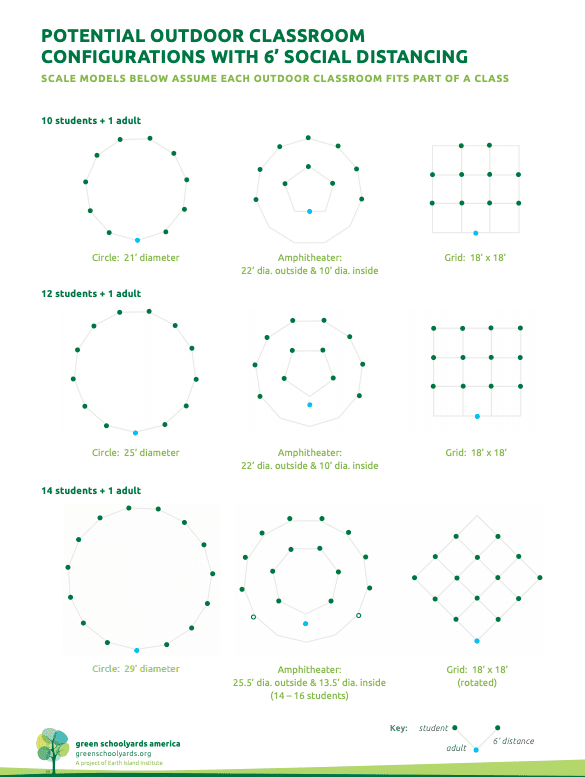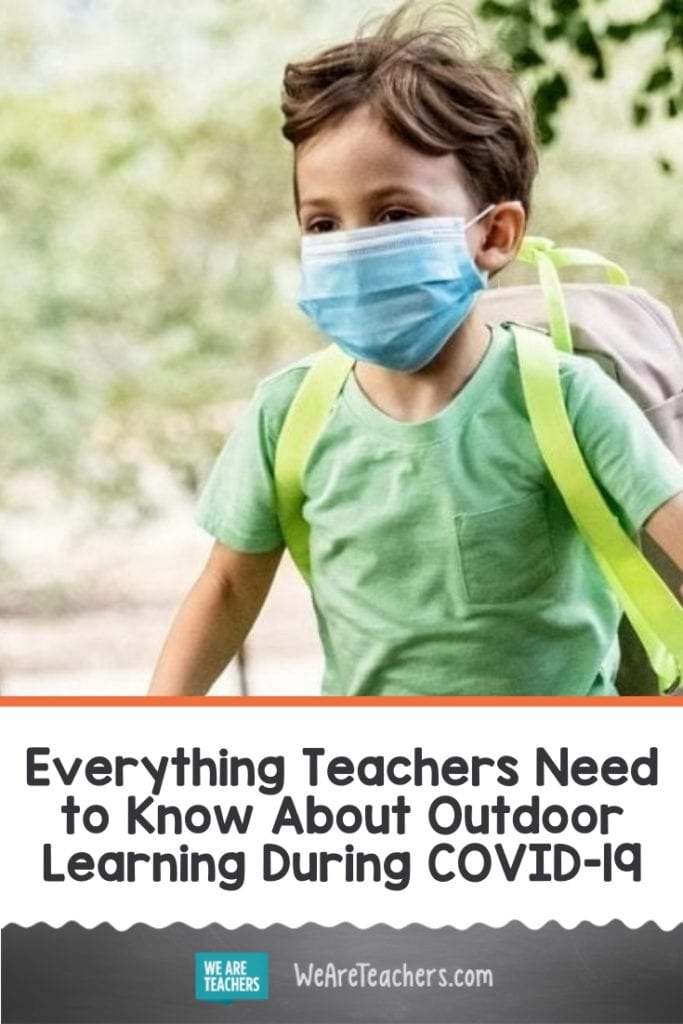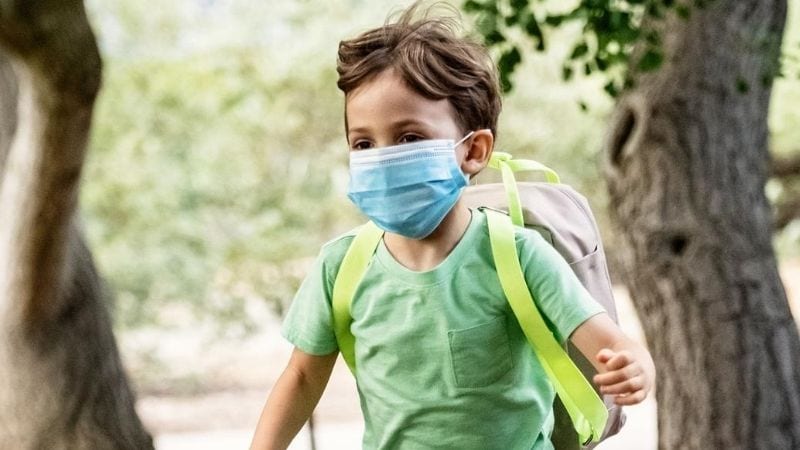As we debate about how to safely offer in-person instruction during COVID-19, many wonder if outdoor learning is an answer. The American Academy of Pediatrics guidance on reopening schools lists “utilize outdoor spaces when possible” as a high-priority strategy. This aligns with the general shift towards moving more of life outdoors, where experts consider the risk of virus transmission to be lower, with appropriate precautions.
Increasing time outdoors for kids isn’t a new idea; research shows outdoor learning and play improve physical and mental health, cognition, attention, and engagement in learning. Present challenges—like requirements for ultra-sanitizing, physical and social distancing, mask-wearing, virus transmission, extra screen time use for kids, and overall societal stress—simply dialed up the spotlight.
The New York Times reported on the historic success of “open air” schools during prior public health crises, issuing a call to action for school leaders to more innovatively consider outdoor learning during this one. Teachers in Brooklyn passionately urged school officials to consider outdoor learning as an equity-building strategy to counteract the disproportionate negative impacts of quarantine for young children of color.
[contextly_auto_sidebar]
Are you wondering about outdoor learning for your school? Here are answers and additional resources for some of the questions that may be on your mind:
What resources are out there to support schools?
Ample resources exist for outdoor learning in general, such as those from Children and Nature Network and Inside-Outside.Two notable COVID-specific ones include:
- The National COVID-19 Outdoor Learning Initiativefrom Green Schoolyards America, based in Berkeley, CA; check here for frequently updated, comprehensive outdoor learning planning resources, case studies, and research documentation.
- eE Guidance for Reopening Schools fromThe North American Association for Environmental Education; download an overview of how environmental and outdoor education could play into successful school reopening with ideas for collaborating with community outdoor education experts.
What exactly are “outdoor classrooms” and what happens in them?
Outdoor learning spaces can be designed for hands-on nature learning—like a pollinator meadow or produce garden. But an outdoor classroom is simply a space set up for group learning outdoors. During COVID-19, what’s most urgently relevant is that outdoor classrooms could give students and teachers an alternative space to spread out, breathe, read, write, talk, and think together.
Laura Newman, a Maine-based outdoor learning advocate affiliated withLearning by Nature for ME and School Ground Greening Coalition, explains, “Educators use online tools and technology, but many aren’t as used to teaching outside. It’s a culture shift to consider this idea, but outdoor classrooms can be used for any kind of learning that would occur in a school building.” She emphasizes that outdoor classrooms can be basic. A whiteboard mounted on posts, 5-gallon buckets for students to use for seating and materials storage, and clipboards for writing surfaces could suffice.

Possible social-distanced outdoor classroom seating arrangements from Green Schoolyards America
Outdoor classrooms sound great, but how can I get my school to envision them?
Creating and using outdoor classrooms in the wake of everything 2020 has thrown at educators might feel like a lot. Yet there are schools in the US and around the world who have rolled out COVID-era outdoor learning practices already. More are actively exploring possibilities that could be shared as examples.
In Portland, Maine’s largest school district, the Portland Society for Architecture created a “rapid response” team to match design professionals with each school. These team members partnered with school leaders to plan potential outdoor classroom spaces to fit social distancing guidelines.
School board members in Seattle drafted a proposal that would combine shortened days of in-person, outdoor learning—on school grounds and in public green spaces—with remote learning. The proposal isn’t final, and district leaders haven’t responded. Still, it may spark thinking about combining outdoor learning with at-home learning for other districts.
Some schools plan to hold classes in tents, as some Danish schools trialed last spring. Tents can be specially designed for school use or perhaps borrowed from event companies in their off-season. There’s even support for closing New York City streets adjacent to schools to create pop-up outdoor classrooms.
Can I still be an effective teacher outdoors?
Raise your hand if you’re imagining your first grade students frolicking like puppies while you futilely attempt to teach a phonics lesson. Laura Newman urges teachers to give themselves credit. “Outdoors doesn’t mean automatic recess. As teacher, you can use what you know about classroom management, just in a different physical space.” This includes strategies like forming outdoor learning rules and expectations, rituals for entering outdoor learning spaces, and setting an agenda for each work period. (Plus, movement breaks are easy when you’re already outdoors!)
What about when it’s too hot, too cold, or too wet?
There are plenty of forest schools in which kids and teachers head outdoors in any weather. That’s likely not a realistic solution for the masses, though. For most districts, outdoor learning makes the most sense during certain seasons. Simple shelters or awnings can provide shade and drizzle protection. Schools could engage community partnerships to make sure kids have weather-appropriate clothing.
Green Schoolyards America says, “We would like to see outdoor learning become ‘Plan A’ for as many students as possible—with online learning and indoor classrooms used as ‘Plan B’ for the days or seasons when the weather is not ideal.” Laura Newman expands on this, urging schools to consider learning outside as a beneficial complement to the isolated and tech-heavy remote learning that is inevitable for many students this year.
What about student safety?
Questions about outdoor classrooms cover everything from bee allergies to school shooters. Student safety is, of course, paramount. Any outdoor learning plan needs to comprehensively anticipate and account for a variety of scenarios, from individual student health concerns to restroom usage and handwashing plans to school emergencies. And, schools must acknowledge that lengthy periods of time outdoors may not physically suit every single student—or staff member.
We’re living in unprecedented times. We can’t directly compare outdoor learning to “typical” indoor classroom instruction this year. “This year is going to be different. Mental health is a priority. In-person connections are a priority,” says Laura Newman. Perhaps this year, outside is where schools have a better chance of addressing those priorities.
Does your school have plans to incorporate outdoor learning as part of its reopening plan? Do you wish it did? Share your thoughts in our WeAreTeachers HELPLINE group on Facebook.


